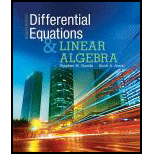
Concept explainers
For Problems 1-6, evaluate the determinant of the given matrix
a.
To explain:
The value of the determinant of matrix
Answer to Problem 1AP
Solution:
The determinant of matrix
Explanation of Solution
Given:
The matrix
Approach:
By using the definition of determinants the value of general matrix of second order is
Calculation:
As, the value of determinant for general matrix of second order is
Then for matrix
So,
b.
The value of the determinant of matrix
Answer to Problem 1AP
Solution:
The determinant of matrix
Explanation of Solution
Given:
The matrix
Approach:
By converting the given matrix to upper triangular matrix in which the entries below diagonal elements are zero and then taking the product of diagonal elements of the equivalent matrix gives the determinant of the matrix.
Calculation:
Firstly apply the row operation as adding one third of the first row to the second row it gives
Thus,
That is,
c.
The value of the determinant of matrix
Answer to Problem 1AP
Solution:
The determinant of matrix
Explanation of Solution
Given:
The matrix
Approach:
According to cofactor expansion theorem the determinant of general second order matrix is given by
Calculation:
So, by the expansion theorem the
Thus,
Want to see more full solutions like this?
Chapter 3 Solutions
Differential Equations and Linear Algebra (4th Edition)
Additional Math Textbook Solutions
College Algebra
College Algebra
Algebra and Trigonometry: Structure and Method, Book 2
Intermediate Algebra (8th Edition)
Intermediate Algebra (7th Edition)
College Algebra with Modeling & Visualization (6th Edition)
- The determinant of a 22 matrix involves two products. The determinant of a 33 matrix involves six triple products. Show that the determinant of a 44 matrix involves 24 quadruple products.arrow_forwardFor the Attached Problem, use the method of variation of parameters (and perhaps a computer algebra system) to solve the initial value problem x’ = Ax + f(t), x(a) = xa . In each problem we provide the matrix exponential eAt as provided by a computer algebra system.arrow_forward1) If A = -5 1 and B = 3 -6 3 2 2 -3 Find:- a) A2 b) determinant A c) AT d) B-1arrow_forward
 Algebra for College StudentsAlgebraISBN:9781285195780Author:Jerome E. Kaufmann, Karen L. SchwittersPublisher:Cengage Learning
Algebra for College StudentsAlgebraISBN:9781285195780Author:Jerome E. Kaufmann, Karen L. SchwittersPublisher:Cengage Learning Linear Algebra: A Modern IntroductionAlgebraISBN:9781285463247Author:David PoolePublisher:Cengage Learning
Linear Algebra: A Modern IntroductionAlgebraISBN:9781285463247Author:David PoolePublisher:Cengage Learning Elementary Linear Algebra (MindTap Course List)AlgebraISBN:9781305658004Author:Ron LarsonPublisher:Cengage Learning
Elementary Linear Algebra (MindTap Course List)AlgebraISBN:9781305658004Author:Ron LarsonPublisher:Cengage Learning College Algebra (MindTap Course List)AlgebraISBN:9781305652231Author:R. David Gustafson, Jeff HughesPublisher:Cengage Learning
College Algebra (MindTap Course List)AlgebraISBN:9781305652231Author:R. David Gustafson, Jeff HughesPublisher:Cengage Learning



